|
Oaracle Upgrades |

|
We were still on the water in WaterTribe’s 2004 Everglades Challenge when thoughts turned to improvements to Oaracle, our 20-foot rowable sailboat. We weren’t doing well in 2004 mostly because of rusty sailing skills from spending too much time building and working on boats and not enough time on the water, and from a fog the first night that hampered our progress. Even though we didn’t make it to the first checkpoint in the required time, we still had a wonderful trip and I was looking forward to trying again with the hopes of a better result. The 2005 race was out because of family commitments, but 2006 — if all goes well — will see Oaracle back on the starting line.
There will be some changes. For one, Helen (aka Admiral Wingnut), whose skin is ultra-sensitive to sun exposure, will be the shore crew. Her place will be taken by Chuck Leinweber of Duckworks (aka Chuck-the-Duck), who also has generously offered to sponsor the entry.
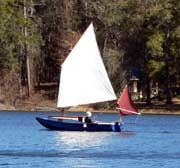 |
The 13 square foot mizzen is dwarfed by the 114 square foot main, but is large enough to provide some needed weather helm and also hold the boat head to wind with no one at the helm.
(click images for larger views) |
|
Oaracle — a Jim Michalak-designed Frolic2 — will basically be the same boat as 2004. But with our experience in that contest and in subsequent sails, there will be quite a bit of tweaking, both in the rig and equipment.
Maybe the most important change will address what a colleague with extensive on-the-water experience described, somewhat unglamourously, as “boat butt.” Sitting on the bare plywood seats of Oaracle, or on the somewhat hard closed cell cushions we used, led to chafing of the skin covering the tailbone and extensive cases of boat butt syndrome. Two improvements are planned. One, a caned canoe seat will be substituted for the plywood rowing seat that spans the cockpit seats. I’ve rowed for about six hours on a caned seat, without the least discomfort at the end. For the cockpit seats, we’ll be using our cushion covers that hold two of the ubiquitous orange life jackets and which provide unequaled comfort for seating. We may experiment with a cover that holds only one cushion, for lower seating and better back support in Oaracle’s deep cockpit.
The donated double paddle cut in half (the aluminum had seized and the halves couldn’t be separated normally) and ready for their dowel extensions.
|
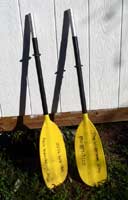
|
|
Our motto: Banish boat butt.
Once that essential comfort is addressed, we’ll be primed to deal with changes to the rig. In 2004 and on other sails, we experienced a slight lee helm while hard on the wind which was a problem at night in the fog with no visual references. Also, since Oaracle only has one sail, reefing meant anchoring even in wide areas of the Intracoastal Waterway, and some testy times getting the sail down. Adding a small mizzen hopefully will address both those problems. The mizzen (which is only 13 square feet) seems to address the helm problem. It also, as of its first test sail, successfully held the boat head to wind with no one at the helm in winds that gusted to about 25 mph.
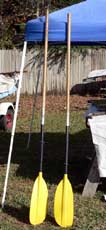 |
The dowel extensions have been glued into the aluminum shafts, but haven’t been cut to final length. The dowels were glassed, with the fiberglass overlapping on the aluminum shaft. The sections above the black part of the shafts were then painted white.
|
|
The second change to the rig is the addition of a 50 square foot or so jib, for use in light airs. It will increase the boat’s sail area by around 50 percent and is hoped to help in winds of 8-10 knots. A drawback is the jib almost certainly can’t be tacked with the balanced lug main up, and will have to be lowered for each tack. But on an expedition type event like the EC, we could conceivably go for hours or even all day without tacking, so that is acceptable. It also makes tacking a two-person operation. The jib also could be used in strong wings with just the mizzen and the main furled. As of this writing, there hasn’t been a chance to try the jib with the main, but the main and mizzen combination worked well in winds of 15-20 with higher gusts that, at times sent the boat along at about 6 knots. Although not terribly close-winded in this configuration, progress could be made to windward. This shows promise of being a good reaching and running combination in strong winds, especially in gusty conditions.
(We’ll pause here a moment to praise David Gray of White Polytarp Sails, who supplied the jib kit and instructions. The only change was to cut a hollow into the luff instead of the round, since this jib is set freestanding. It suffered a lot of abuse on its first windy sail and took it all in stride.)
The oardle in its paddling configuration. This shot also shows the boat in its (polytarp) jib and mizzen rig, although in the wind shadow of some tall oaks on land. Where the water is rippled behind the boat, it’s blowing 15-20.
|
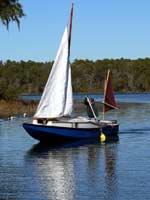
|
|
In the 2004 EC, someone dubbed us the “wine and cheese boat.” Until then, I didn’t realize we were the only craft in the contest with a cabin. That wasn’t deliberate, per se. When we decided to enter the EC and build a boat, the natural choice was a Frolic2 because I had always wanted one. Getting a cabin was a bonus. Because Helen is talented with a sewing machine, we also had made 4" thick cushions for the cabin sole that are more comfortable than a store-bought mattress.
Alas, we probably won’t lose the wine and cheese label for 2006. The accommodations will remain largely unchanged. An air mattress may be substituted for one of the cushions to save a couple pounds. The big addition for the race is a 31 amp-hour battery and a simple electrical system. The main reason is Oaracle has a very nice Ritchie compass, which does not have a night light (well, it does have one, but it’s broken). After the fog experience of 2004, I was determined to rectify that. The battery allowed the installation of a waterproof 3-LED red light over the compass that’s so bright I had to mask part of it with black tape. Yeah, a flashlight probably could have been rigged up to light the compass, but I wasn’t interested in jury-rigged or half measures. If all we use is the compass light, the fully charged battery should run it for a month of night sailing, or more.
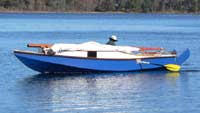 |
The oardles in their rowing configuration. They seemed to move Oaracle at least as well as regular oars.
|
|
But of course once a battery is in, other “conveniences” follow. In this case, a necessity for hot weather sailing in Florida, but not for this race since it is run in early March, is a cabin fan, rated to draw a half amp or so. In the warmer months, even with the center slot open, it can be nice to move air when the wind dies, day or night. It may come in handy on the EC, as it can get warm that time of year, especially in the Everglades/Florida Bay sections of the race. Since I hate fumbling around in the dark looking for something with a flashlight in one hand, I’ve installed a couple cabin LED lights, plus a small light in the stern locker. Left out were LED running lights connected to the 12-volt system. We’ll continue to use the Tektite LED lights that run for 100 hours on AA batteries. It’s simpler than installing running lights, and probably more reliable. If something happens to the 12-volt battery, at least we’ll still have running lights.
A penalty for having the cabin is reduced rowing ability. It may seem strange for a boat with only about 33 inches of headroom in its cabin, but that hurts the rowing ability when trying to go upwind. Michalak recommends narrow bladed oars for extended rowing without fatigue, but we had some problems with that. The narrow oars don’t develop a lot of power when bucking a tide or light-to-moderate wind (there’s no bucking a heavy wind or tide under oars). Plus to get to the first checkpoint of the EC, it’s necessary to pass under a 9 foot clearance bridge where the pilings are only about 10 feet apart — too narrow for the about 14 foot rowing wingspan of Oaracle. Oars don’t make good paddles and narrow oars are even less suitable.
| One last addition for the race -- folding steps, sold by Duckworks, bolted to the cockpit seat framing to use as foot braces for rowing and which can be folded out of the way when not needed. |
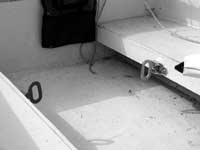
|
|
The solution came when I was at Wilderness Way, a local canoe/kayak shop here in Tallahassee, FL, ordering the caned canoe seat for rowing. Since we already had carbon fiber double paddles for our kayak, I inquired if they had any broken shafts from other double paddles. My thought was to make removable extensions for our paddles, so they could be used at the bridge. The answer was no, but the clerk volunteered that they had an old aluminum shaft double paddle that the owner had instructed him to toss, since it had a slight bend in the handle. Intrigued by the EC (he hadn’t heard of it before), he donated the paddle to the cause. The paddle was cut in half, and 1 1/4-inch dowels inserted to extend them to oar length. Since the paddle end was still heavier than the handles, the wooden shafts were covered with spiral wound glass tape and epoxy. The result seems as strong as my home-built and commercial oars and the dowel seems a comfortable size for my hands. We now have spoon-shape bladed oars that can instantly convert to long-handled paddles for the EC’s pesky Checkpoint 1 bridge. In honor of Oaracle, we’re calling our hybrid propulsion “oardles.”
In their first test, the oardles performed well both rowing and paddling. One discovery is that for short distances, it was easier to whip out one oardle and begin paddling rather than go to all the work of removing oarport covers and installing the oars. If someone is along to steer, it almost isn’t work.
Those are the main changes planned for the 2006 EC. Some more may creep in. But as the old year dies and the new takes flight, the emphasis is shifting from boat work to training and sailing. I’m looking for a good foggy. soggy night . . . .

Other articles by Gary Blankenship & Helen Snell:

|